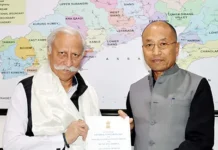Flights Of Fantasy
[ M Panging Pao ]
What is your mobile number? My mobile number is nine por tree sik zero pipe pipe por por zero… this is how many of us will pronounce 9436055440.
Belonging to the Tibeto-Burman stock, most of the native people of Northeast India have typical vocabulary, intonation and pronunciation traits. These typical traits could be due to usage over hundreds of years and maybe some genetics also. There are many words and pronunciations typically used in this area only. Pronunciations/words like ng, ngo, nyi, é, and í are typical to this area. Names like Phongwasun Ngamgadam, Thangwagam Lowangading, Mewlai Tingakhatra, etc, appear as tongue twisters to other Indians, just as Chinnadorai Subramanian, Elangovan Namboodripad, Mulayil-thara Sadasivan are tongue twisters to us.
Most mainlanders would pronounce the name Míbang as Meebang or Mibang, Émul would be pronounced as Imul or Amul, Ména would be called Mina or Meena, ngo would be pronounced as no, donyi would be pronounced as doni, nyodu would be called nodu, nyago as nago.
Likewise, most natives cannot pronounce certain syllables and pronunciations. Think would be called tink, four would be called por, five would be called pipe, six would be called sik. Hindi words like achha would be called assa, bhindi would be called bindi, chhuri would be called suri, etc. There is difficulty in pronouncing words/syllables with requirement to roll the tongue with the upper mouth.
Then there is this Assamese connection with older names and words. a is pronounced like o, Arati or Aarti is Aroti, Anima is Onima, Bharati is Bharoti, etc. Roti is called ruti.
There are typically words prevalent in the Northeast due to usage. Bitter gourd is called Kerala instead of karela – Kerala is a state of India. Brinjal or baygan is called baygun. In entire east India, samosa is called singhara, mungphali (ground nuts) is called badam.
When the Hindi teacher taught “Ka, Kha, Ga Gha, Nga,” the native student repeated “Ka, Ka, Ga, Ga, Nga.” The teacher scolded the student. However, the issue was that the student could not pronounce kha and gha.
With many students studying outside the region and with wide proliferation of Hindi movies and Hindi TV channels, pronunciation is improving. Occasionally, one can hear native comperes/emcees and announcers using correct pronunciations of both English and Hindi languages. Otherwise, listening to speeches in Hindi by our leaders is a hilarious experience.
With improvements in pronunciation, shopkeepers will not give you bindi when you ask for bhindi… and we will not be eating Kerala and baygun. (The contributor is retired Group Captain, Indian Air Force)


